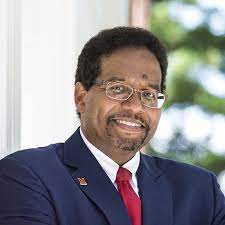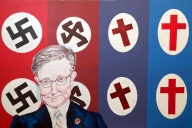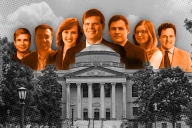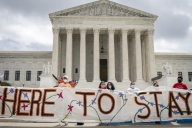You have /5 articles left.
Sign up for a free account or log in.

DesRoches (left) and May have been friends and colleagues since they met at Berkeley Engineering.
Courtesy of Georgia Tech
When Reggie DesRoches assumes the presidency of Rice University on July 1, he will become the fifth Black leader of a top research institution.
He will also be the third Black president in the 65-member Association of American Universities who attended the UC Berkeley College of Engineering, along with Gary May, now the chancellor of the University of California, Davis, and Darryll Pines, president of the University of Maryland, College Park.
The three men pursued different disciplines at Berkeley and overlapped for only a short time in the mid-1980s. But they credit the institution with supplying the training and support network that launched their remarkably similar trajectories.
“For all of us, [Berkeley Engineering] provided a foundation of excellence and knowledge that we’ve been able to take forward in our careers,” Pines said.
Each man rose to the top of his field: May in electrical and computer engineering, Pines in mechanical engineering, and DesRoches in civil engineering. All three served as engineering school deans—Pines and DesRoches at the institutions they now lead, and May at Georgia Tech. All three have been named to the prestigious National Academy of Engineering and now head up large research universities.
Whatever role Berkeley Engineering played in their success, however, it’s clear in speaking to them and others that their experience signaled not the ascendancy of Black students in STEM but rather “a unique moment at the university,” as DesRoches put it. “There was a strong population of both Black engineering students and Black graduate students. It was just a special time when we were there.”
By the late 1990s, a combination of anti–affirmative action legislation, budget cuts and shifting priorities among new leaders at Berkeley decimated efforts to recruit and graduate underrepresented minority students.
“All those things had a chilling effect on the matriculation of Black students in engineering—particularly at the graduate level,” said May. “I’m not saying our experience couldn’t be replicated, but it would be harder today.”
Friends and Mentors
When DesRoches entered Berkeley as a freshman in 1985, Pines was a rising senior who mentored him and other young Black engineering students. May arrived the following year to earn his master’s and Ph.D., but as chair of the National Society of Black Engineers, his reputation preceded him.
“Gary was a big man on campus,” Pines said. “We were all nobodies, but Gary had migrated to the top of the organization. And then he shows up to Berkeley in January, we’re like, ‘Wow, we got the president at our university.’”
The three met through the Black Engineering and Science Students Association (BESSA), which held events and maintained an office on campus where Black students hung out. May helped establish a sibling organization known as BGESS, for the Black Graduate Engineering and Science Students.
BESSA and BGESS complemented the carefully constructed minority engineering program (MEP) Berkeley had developed to help Black students succeed. The program was grounded in workshops, based on mathematician Uri Treisman’s model of fostering collaborative problem solving to help students from underprivileged backgrounds master the material together.
“The whole work was the integration of academic and social spheres,” said Toni Torres, a 1981 Berkeley graduate who was hired by then College of Engineering dean Karl Pister to run workshops for minority students. “Those workshops weren’t just about doing the math; this was a coming together of a scholarship group, it was creating their academic identity and sense of belonging, creating a community that was engaged in their success and the success of their peers. And because of that cascade mentoring, you always had role models.”
For DesRoches, that meant May and Pines.
“When I was a first-year student trying to figure out my way, they were both role models for me,” DesRoches said. “There was just this culture of seniors and graduate students sort of looking down on the young folks saying, ‘Hey, you guys have got to stick it out. You guys need to think about graduate school.’ And Gary would stop by the office on campus, just to talk to students. There was this incredible culture around supporting each other.”
The mentors benefited as much as the mentees.
“It was lonely,” May recalled. “There weren’t that many of us. That was a big motivator for me, just to be around people that have similar backgrounds and struggles and issues.”
 Pines remembers being in a freshman statics class and noticing some of his white classmates poring over a thick binder of notes, which he discovered were the statics exams and problem sets from the last decade, passed down through a frat house.
Pines remembers being in a freshman statics class and noticing some of his white classmates poring over a thick binder of notes, which he discovered were the statics exams and problem sets from the last decade, passed down through a frat house.
“These guys wouldn’t even come to class, and they were like, ‘Oh, I got a perfect score [on the exam],’” he said. “And I killed myself to get an 89. So they’ve been cheating in a sense. And this is part of the problem: when you’re a person of color, you’re not connected to the network.”
The MEP sought to build a network for students of color. Sheila Humphreys, who served as a director of diversity at Berkeley Engineering in the 1980s and 1990s and became the first academic director of graduate outreach, attributes the program’s success to two key factors: unwavering administrative support, emanating from the late Dean Pister, and a comprehensive, whole-student approach.
“The whole idea was to have continuing support from the moment students got there through graduation,” Humphreys said, beginning with summer “bridge” programs and freshman boot camps.
As director of graduate outreach, Humphreys even played a role in admissions, advocating that the program accept Ph.D. candidates from HBCUs and other institutions that Berkeley Engineering didn’t typically draw from.
Kamau Bobb, who earned his undergraduate and master’s degrees from Berkeley Engineering beginning in 1990, says he greatly benefited from having mentors of color—including May and DesRoches, who remains a close friend.
Many of the grad school instructors “were themselves Black and brown students,” said Bobb, now senior director of Georgia Tech’s Constellations Center for Equity in Computing. “So our introduction to calculus, physics, chemistry, introductory [mechanical engineering] and CS and [electrical engineering] was through our own folks. And their kind of sensibilities and all those things that you’d expect were built in.”
The End of Affirmative Action
Everything changed in 1996, when California passed Proposition 209, which banned preferential treatment based on race, sex, ethnicity or national origin in public employment and education.
“Prop 209 was a big win for white supremacy,” said law professor David Oppenheimer, director of the Berkeley Center on Comparative Equality and Anti-Discrimination Law. “It achieved exactly what its promoters wanted: to ensure that programs that were successfully bringing more students of color to the University of California would fail, and that the result would be fewer people of color in leadership positions in government and industry.”
“That that was the death knell for the [minority engineering] program,” said Torres. “People really struggled to figure out how to sustain the mechanics of the program when you couldn’t really target students for participation in the same way.”
Across the university, the share of Black freshmen enrolled fell from 6.7 percent in 1995 to 3.7 percent in 1998, eventually plateauing at around 3 percent. Today Black students make up about 4 percent of Berkeley’s undergraduate population.
Data from Berkeley Engineering do not separate Black students from other “underrepresented minorities,” which include Native American and Latino students. But an analysis by Fiona Doyle, a former engineering professor, found that freshman enrollment of underrepresented minorities dropped by more than 40 percent between 2005 and 2009, from 10.4 percent of the class entering in 2005 to 6.2 percent of the class that started in 2009.
Tsu-Jae King Liu, the current dean of engineering, said that following the passage of Prop 209, the number of Black undergraduate engineering students fell by about 1 percent—a decline that remained largely flat until recently. Data show that in the 2021–22 academic year, underrepresented minorities made up 20 percent of engineering undergraduates, though just 8 percent of graduate students.
“This is actually the first year that we ended up with a higher percentage than even before Prop 209,” Liu said.
Students and faculty tried to compensate for Prop 209 by establishing MEP-like programs, such as the Center for Underrepresented Engineering Students (CUES). But sustaining momentum proved difficult. As a public institution, Berkeley couldn’t offer the kind of financial aid its private counterparts could, so it lost qualified candidates to institutions such as Stanford and MIT. Doyle’s report noted in all caps that in 2009, “Engineering had THE LOWEST YIELD OF UNDERREPRESENTED FRESHMEN OF ANY UNIT ON CAMPUS.”
Despite vehement opposition from students, Berkeley merged CUES with Engineering Students Services, a broader student support group, in 2009.
“CUES served a very small cross-section of our students,” said Liu. “And so that’s why it was integrated—plus, Prop 209 made it more difficult to justify. Some of the minoritized students who benefited most from that program probably felt that we were reducing some support for them. But the idea was really to be more inclusive and supportive of all students to succeed.”
Caleb Bugg, who recently completed his Ph.D. at Berkeley Engineering and is now doing a postdoc at Georgia Tech, understands the administration’s position.
“It’s not like I think the people in the College of Engineering are evil; they’re just spread so thin,” he said. “There’s an all-Black organization; it’s running well. And then people say, you need to bring in other people who are also oppressed in some way. So, of course, you want to bring them in, too, but …”
He notes that BESSA and BGESS, the Black affinity groups that nurtured May, Pines and DesRoches, are as strong as ever. Bugg, who served as a vice president of BGESS, estimates that roughly 70 or 80 of the 110 members regularly showed up to events.
But without funding, administrative oversight or academic coaching, they remain largely student-run social organizations, and Bugg believes they could be so much more.
“The real power of these organizations is us being exposed to other people’s research and other people’s work to the point where you can say, ‘I could see an all-Black research group doing work that goes in a major journal, and that’s not weird to me, because I saw it in graduate school,’” he said.
The Future of Black STEM Scholars
Pines, who grew up in Oakland, graduated Berkeley in 1986 and moved across the country to attend graduate school at MIT. May and DesRoches studied and worked together for years at Berkeley, and then later at Georgia Tech, where May helped DesRoches get his first faculty job.
But the three men remained in touch, never forgetting the sense of community and possibility they found as engineering students at Berkeley.
Today they remain committed to ensuring a robust pipeline for future STEM scholars of color.
“We know how to do this,” said May. “There are hundreds, maybe thousands of programs that have been successful. But they’re not knitted together in any reasonable way. And there’s no consistency from year to year. Most of these programs depend on charismatic leadership as opposed to a national imperative or national will to solve the problem. So I use the Bush 1,000 Points of Light metaphor: there’s a thousand points of light here, but no constellation.”
May and Pines serve on the National Academy of Engineering’s newly formed Committee on Racial Justice and Equity.
“What we’re doing now is trying to align those programs, so there are some synergies that make it easier for folks to go from undergrad to grad to scholarship funding,” said Pines. “As Gary has said, diversifying STEM in general is a national imperative. If the government wants the United States to still be at the forefront of STEM education, and therefore technology accomplishment and contributions, we need to invest in diverse populations and do that nationally.”
Among the steps they recommend: creating a national STEM scholarship program based entirely on need, and establishing a national database of underrepresented STEM students at every stage of their career.
More than 35 years after the three presidents connected at Berkeley, their legacy still looms large—on the campus and beyond.
“I met Gary May recently. He’s been an idol of mine for a very long time,” said Bugg, who aspires to be a college president.
“The work that Gary, Reggie and Darryll did, while they were at Berkeley and after, helped create the environment that will allow the next generation of American engineers and scientists to see that they, too, could do something similar, that they, too, have a right to be in these spaces, that they, too, can help create and mold not just American society, but the world writ large,” said Ryan Shelby, who got his master’s and Ph.D. from Berkeley in the 2010s and now works for USAID in South Africa. “The work that these guys did as well as their experience there helped shape and mold the next generation, and I am living proof of that.”








